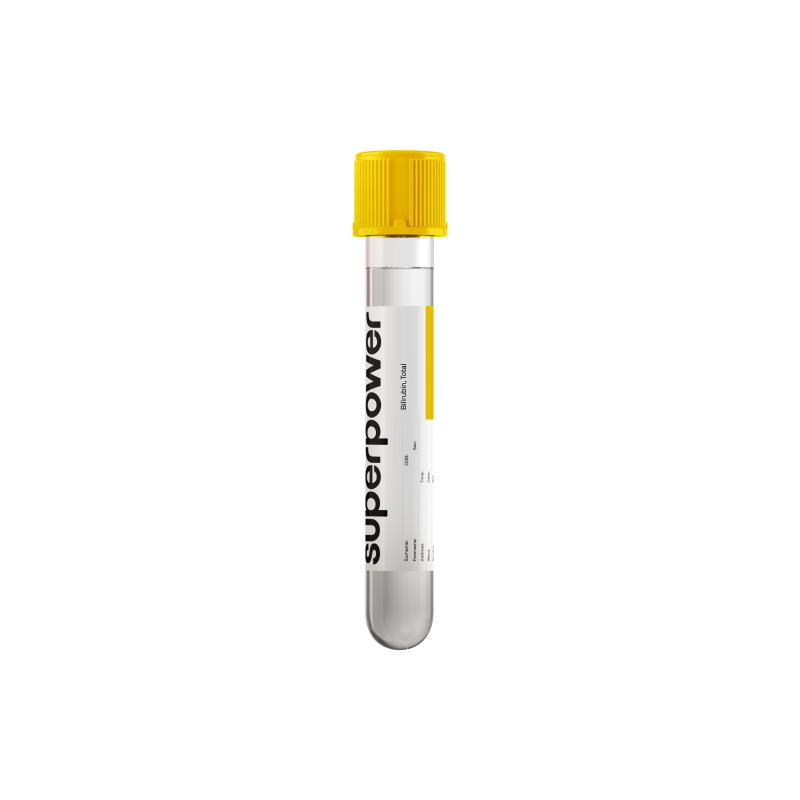Track total bilirubin to understand liver function, bile flow, and red blood cell turnover. Clear insights, trends, and context within a complete liver panel.
Key Benefits
- Check how your body clears bilirubin to assess liver and bile duct health.
- Spot jaundice risk and bile flow problems from liver disease or duct obstruction.
- Clarify yellow skin, dark urine, or itching by confirming and grading jaundice.
- Explain whether elevation fits hemolysis, Gilbert syndrome, or liver dysfunction when combined with fractions.
- Guide urgency for hepatitis, gallstones, or cholestasis when levels rise quickly or markedly.
- Track treatment response and recovery by following bilirubin trends over time.
- Support pregnancy safety by flagging liver or bile duct issues requiring prompt evaluation.
- Interpret results best with direct/indirect bilirubin, ALT, AST, ALP, GGT, symptoms.
What is Bilirubin, Total?
Bilirubin is a yellow pigment made when your body breaks down worn‑out red blood cells. As the heme part of hemoglobin is dismantled, it becomes bilirubin (unconjugated or “indirect” bilirubin), which is not water‑soluble and travels in blood bound to albumin. Liver cells then attach a small sugar acid (glucuronic acid) to it, a step called conjugation, creating water‑soluble bilirubin (conjugated or “direct” bilirubin) that is released into bile and sent to the intestine.
Total bilirubin is the sum of both unconjugated and conjugated forms circulating in your blood. It serves as an integrated readout of heme recycling, liver processing, and bile delivery. In other words, it reflects how efficiently the body clears hemoglobin’s waste products and hands them off to the gut for final disposal, where bacteria transform them into downstream pigments (urobilinogen and stercobilin). Because it captures these linked steps, total bilirubin offers a simple window into the flow of this cleanup pathway.
Why is Bilirubin, Total important?
Bilirubin, Total is the combined amount of unconjugated and conjugated bilirubin—the yellow pigment created when hemoglobin is broken down. The liver extracts it from blood, conjugates it, and excretes it into bile. Because it links red blood cell turnover, liver cell function, and bile duct flow, it offers a single, system-wide snapshot from bone marrow and spleen to liver and gallbladder.
Typical adult reference spans about 0.2–1.2. Most healthy people fall in the low-to-mid portion of that range. Within normal limits, men tend to run slightly higher than women, and fasting can nudge levels up; steady low-to-mid values are generally considered optimal.
When values sit unusually low, they usually reflect reduced heme breakdown or efficient hepatic clearance. This seldom produces symptoms. Observational data link very low levels with higher oxidative stress and cardiometabolic risk, but a low result alone is nonspecific and rarely a standalone disease signal.
Higher values arise from three pathways: increased production (hemolysis), impaired hepatic uptake/conjugation (such as Gilbert syndrome or hepatitis), or impaired bile flow (cholestasis from gallstones or duct obstruction). Effects ripple across systems: yellow skin/eyes, dark urine and pale stools when conjugated bilirubin accumulates, itching with cholestasis, and fatigue or right‑upper‑quadrant discomfort with hepatocellular injury. Newborns commonly have transient elevations; very high levels can endanger the brain. In pregnancy, any rise warrants evaluation for cholestasis or hemolysis.
Big picture, bilirubin integrates the heme–liver–bile axis. Interpreted alongside ALT, AST, alkaline phosphatase, GGT, hemolysis markers, and a CBC, it localizes dysfunction and tracks recovery. Persistently high levels signal liver or biliary disease risk; stable normal levels reflect balanced red cell turnover and oxidative physiology.
What Insights Will I Get?
Total bilirubin measures the sum of unconjugated (indirect) and conjugated (direct) bilirubin—pigments produced when hemoglobin is broken down, then processed by the liver and excreted in bile. It integrates red blood cell turnover, liver conjugation capacity, and bile flow. Because bilirubin also acts as an endogenous antioxidant, levels can mirror oxidative stress and relate to cardiometabolic and hepatic health.
Low values usually reflect reduced heme breakdown or brisk hepatic clearance (hypobilirubinemia) and are rarely a standalone disorder. They can track with a smaller circulating antioxidant pool and have been linked to higher oxidative stress and metabolic risk. Levels tend to be lower in women than men and often fall further in pregnancy due to hemodilution and enhanced clearance.
Being in range suggests balanced red cell turnover, intact liver conjugation (UGT1A1 activity), and unobstructed biliary excretion—supporting stable digestion, detoxification of heme, and redox balance. There is no strong consensus that “optimal” sits at a specific part of the reference interval; values across the reference range are generally compatible with healthy physiology.
High values usually reflect increased production (hemolysis), impaired conjugation (e.g., Gilbert syndrome), or reduced excretion from hepatocellular injury or cholestasis/obstruction. System effects include jaundice; dark urine and pale stools point to conjugated elevations. Newborns commonly run higher due to immature conjugation; extreme elevations in infants can be neurotoxic. In pregnancy, high bilirubin warrants evaluation for hepatobiliary disease.
Notes: Fasting, illness, vigorous exercise, and menstruation can transiently raise bilirubin, especially with Gilbert syndrome. Certain drugs (e.g., atazanavir) increase levels. Smoking lowers bilirubin. Light exposure can falsely lower measured bilirubin; hemolyzed samples can distort results. Fractionating into direct/indirect aids interpretation.



.svg)



.png)
.png)
.png)
.png)








